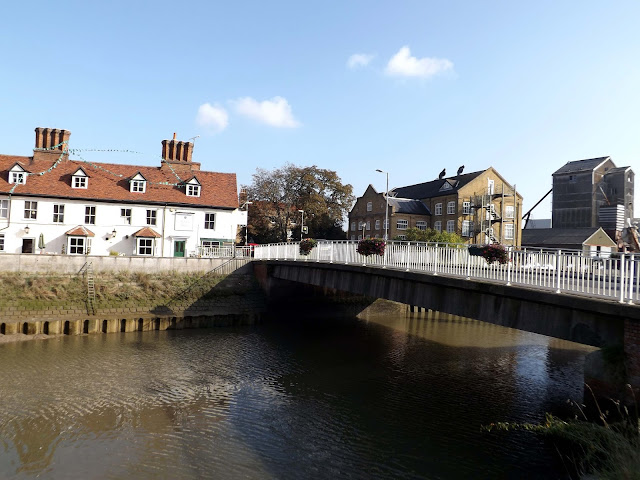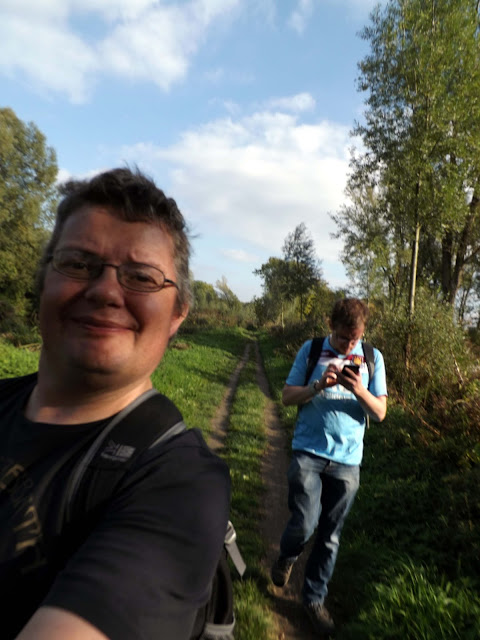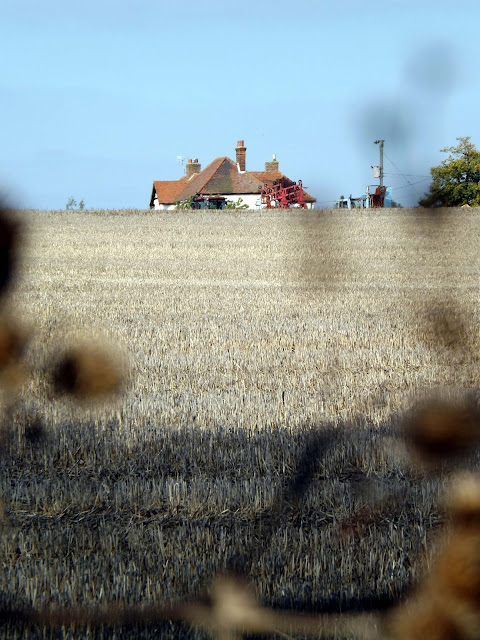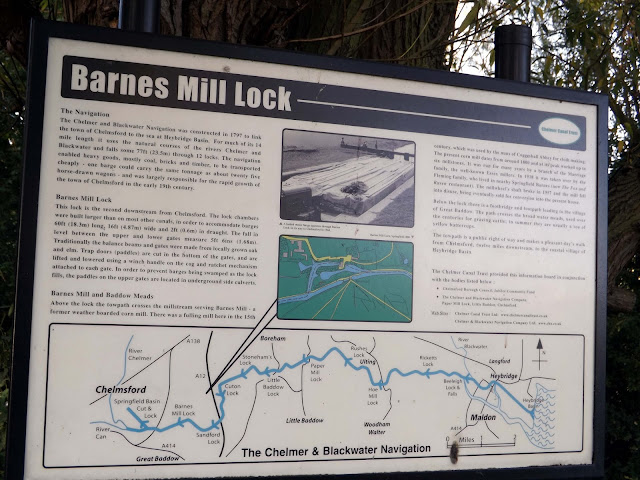The precise date of the building of All Saints’ Church is not recorded, but that it existed in 1180, the date of the foundation of Beeleigh Abbey, is practically certain, for a Charter of Richard 1st in December 1189 exists reciting and confirming “certain grants to Beeleigh Abbey, including the Church of Blessed Peter in Maldon and the Church of All Saints’ in the same town.”
All Saints' Church is built of flint and stone and is one of the most interesting churches in the county having an equilaterally triangular tower which is quite unique
The statues in the niches of the outside walls commemorate six notable men
in some way associated with the history of Maldon.
 |
| Maldon High Street |
We then turned right down Cromwell Hill and down to the waterside by Fullbridge.
Fullbridge sits at the bottom of Market Hill at the crossing over the river Chelmer.
It is home to the wharf of Green's flour
mills and, further along the river, the now empty wharves of Sadds
Timber await development.
On the opposite bank there are several boatbuilders yards where you can often see a sailing barge being repaired or restored.
Fullbridge Wharf is also home to the old
brewery built for the Shrimp Brand beer in 1924. Currently an
industrial unit, this building may be demolished to make way for a
housing development. The brewery also owned the White Lion pub at the
bottom of Market Hill.
The large building by the roundabout is
part of the old Maldon Ironworks Company. Among the products
manufactured by this firm were many of the cast iron signposts still to
be seen at the roadside.
 |
| The Sunny Sailor PH |
Seeing as Dan had bought the map I decided to let him navigate. We took the wrong side of the river to follow it the whole way. Had I navigated? Possibly the same mistakes, who knows. Nice walk through the countryside all the same and there was more than enough riverside walking.
Plenty of blackberries to eat as we make our way along the path.
 |
| Riverside path finishes here. |
We reach Little Beeleigh Farm where we take another wrong turn that led no-where so we back track.
I saw a tree of apples that look irresistible, so a quick look around and I make my way over to do a bit of scrumping. A quick dash back onto the path with two apples.
Dan asks what type of apples are these? I reply no idea they had no stickers on them. Still very nice all the same!
We head out onto Manor Road where there is quite a bit of road walking before we reach Hoe Mill Lock. Plenty of buzzards and kestrels around here and the odd pheasant or two as well.
Hoe Mill Lock has the largest drop on the Navigation, at 8 feet and 3 inches. As a result there is a danger of swamping the boats when filling the lock, and so the lock paddles on the upper gates are located in underground side culverts. The lock is named after a corn mill which had existed near the site from Saxon times to 1914 when it was demolished. In 1795, Hoe Mill was bought by Robert Marriage. His sons, Robert and James, inherited the mill. They were both Quakers and deeply opposed to the slave trade.
They decided to build a sugar beet mill on the banks of the canal, believing that locally produced beet sugar would undermine the importation of cane sugar largely produced in the Caribbean using slave labour. Their aim was "a desire to obtain the best information and to promote the abolition of slavery, by producing an article of free labour." The mill was sited half a mile downstream from Hoe Mill, near where this walk first joins the towpath. The mill employed 30 men, women and children. The process of converting beet into sugar consisted of first rasping the sugar beet roots and then crushing the beet to a pulp which was pressed. The resulting liquor was reduced by boiling and then clarified, then finally any remaining liquid was evaporated off and the residue crystallised. The left-over pulp was used as cattle feed. Sadly the mill failed after just 2 years partly, it is believed, through the resistance of various influential businessmen who wished to continue to import from the West Indies.
There is a Camping and caravan site next to this lock, what a tranquil place to camp.
We follow the path along and pass All Saints Church at Ulting. I visited this church on a previous walk. A lovely church in a charming setting.
All Saints, the village church, has been standing since 1150, with a major restoration taking place in the 1870s. The church was once a place of pilgrimage ranking with Walsingham and other famous shrines.The River Chelmer runs next to the church and through Ulting.
Dan is new to Geocaching and there are no shortage of caches on this walk. However we had to stop at 20 as it was eating into our walking time and we still had a good distance to go.
We reach Rushes lock where we take a quick break for some photos.
Essex Police were out on the river training with a spaniel onboard. I was very conscious of how suspicious Dan looked hunting in the undergrowth for caches that I suggested we best move on.
We now reach Papermill Lock the highlight of the walk as far as I'm concerned. Even if you don fancy a walk you must visit just to relax and sample the Delicious cakes the tea room does here.
Papermill lock is a popular and beautiful tourist location, although in mid Essex, it is ideal for a day in the countryside. Papermill lock offers canal cruises along the unspoilt Chelmer and Blackwater Navigation.
The original water mill on the lower island at Little Baddow was built in Saxon times, and by 1573 a second mill, Huskards, had been built on the same island. Both mills were run by one John Hawes, who was fined 2 shillings because:
'by penning of his waters above his mark hath and doth damage to all the Queen's tenants and farmers of the honour of Bewleigh in drowning the meadows and low grounds and for not drawing up his gates upon rage of waters in the hay time and also hath marred a certain highway or lane leading from Baddow bridge unto the mill called Huskardes mill which the said miller is to repair and amend for the avoidance of further inconvenience'.At that time Huskards Mill operated as both a corn mill and as a mill for fulling cloth. In the 1750's it became the first paper mill in Essex, run by Thomas Hodges and employing 3 men with papermaking skills and an apprentice. In around 1800 the mill was taken over by Benjamin Livermore who continued to operate it as a paper mill for almost another twenty years until it was re-converted for grinding flour. Following the creation of the canal in 1797 a wharf was built here, together with an overnight bothy for the bargees, stables for the horses (now the tea house), and paddocks for livestock.
Of course we stopped at the tea room for tea and cake. I opted for Carrot cake whilst Dan went for the coffee and walnut. Very nice too.
After a quick toilet break we pushed on down the path.
We cross the path over the bridge and down back onto the towpath the other side and past a fisherman.
 |
| A weir |
We walk on doing a few caches here and there.
To our right is the A12 Cuton fishery, looks lovely although can't see myself enjoying a days fishing here with the A12 noise.
The A12 is nearby and all you can here now is the road noise, the tranquility of the river is broken.
 | |
| A Pill-box at Stonhams Lock |
After much walking we eventually are walking under the A12 and onwards towards Chelmsford.
A quick break to stroke and feed the horses.
 |
| A TVR not seen one of these in many a year. |
We pass through Sandford Mill Lock.
We reach Barnes Mill Lock after much more walking.
After crossing the bridge we walk as far as the A138 where the River should go under the A138 but the path is closed a there is construction work ongoing. We have to head back the way we came. I was very disheartened by this. By now my feet and ankles were aching and I didnt need the extra miles.
We cross back over the white bridge and turn by Barnes Mill Lock and out onto a road that led to the A138. We walked for a bit and took another footpath to the town centre.
After much walking we reach The Hop Beer Shop, a regular haunt for Dan. we stopped in and had a pint of XT2 from the XT Brewey. A much needed rest, I finished my pint and said my farewells and made my way back to the train station for the journey home. A long lovely walk of 15 miles, but with my aching feet it feels like much more.















































































